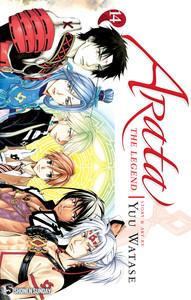Review
by Rebecca Silverman,Arata: The Legend
GN 14
| Synopsis: |  |
||
Having been whisked away by Hiruha to the exile island of Muroya, Arata Hinohara learns of the tragic events of fifty-two years ago, when Yataka and Princess Kikuri had their brief escape. This event is tied up not only in Hiruha's past, but also in the immediate future of Hinohara and the remaining Sho as the six Shinsho have plans that the five elemental Sho clearly did not know about. As powers spin out of control, will Hinohara have the skill to stop the destructive forces? |
|||
| Review: | |||
Readers of Yuu Watase's past works will remember those pivotal moments when everything goes to hell. It is, perhaps, one of her greatest skills as an author – to have things be going along, albeit far from perfectly, when suddenly one thing triggers a maelstrom of disaster. Arata: The Legend's fourteenth volume comes very close to being that moment. With a higher body count than any recent book in the series and a more intense tragedy factor, this volume may not be the absolute best, but it certainly packs a punch. This book picks up directly where volume thirteen left us – Akachi has been defeated, Kannagi's loyalties are in question, and Hiruha, a zokusho who has been with Hinohara's group for a few books now, insists that Arata come with him to the island of Muroya. Muroya was once the hub of the slave trade, and after slavery was outlawed it became a place of exiles and unfortunates. Hiruha's family is from there, and he wants Hinohara to learn about the events of fifty-two years ago. Needless to say, there is an ulterior motive, and a good third of the book is spent in flashback, showing us precisely what happened and allowing us to reconnect with Sho we have not seen since they submitted to Arata. This past segment is interesting not just for this reason, however. It also serves to show us what the world was like previous to the plot to kill Kikuri, how the Shinsho worked together to help the kingdom, and gives us the definite feeling that something must have gone terribly wrong sometime in the last fifty years to bring us to the point where the story takes place. While this volume does begin to delve into just what it was that derailed the country, we only get bits and pieces, and at this point it is up to readers to guess just how things got to the point they were at when the series began. All of this helps us to form a much clearer picture of Kannagi in particular, a task begun in the previous volume. Given the decidedly malevolent character he was presented as in the beginning of the series, it is arguable that he is second only to Arata Hinohara in terms of character evolution, which is interesting when we consider that he was, initially, the bad guy. Kotoha fans will not find much this time around, and indeed her entire manner is somewhat disappointing. She has gone from devoted, if not fierce, companion of Hinohara to a background character, ceding ground to Mikusa. Granted, Mikusa has made some very good progress in terms of self-realization, a trend that continues here with good results and a couple of very funny faces, but the way that she has eclipsed Kotoha is troubling, as if Watase felt that there couldn't be two dominant female characters in the same party in a shounen manga. Hopefully this course will not last much longer, as both have a lot to offer to the group at large. Pages are a little more dense than they have been this time around, with smaller panels crowded with more action. Watase also makes more use of long panels that flow across two pages, which works quite well for the epic nature of the events in the volume. Some of the architecture is especially good, with an altar on Muroya having a particularly nice design and the special train's tracks looking like something out of science fiction rather than fantasy. The idea that this world has a “train” is a little disconcerting at first, although why that should be when airships don't seem odd may indicate that this is a personal issue rather than a larger one. The train's design is fascinating, though, as are the shapes the malevolent energy takes in the flashback chapters. Volume fourteen could reasonably be called a turning point book in the series. While it doesn't cement what Hinohara's future course of action will be, it does give us more information about past, present, and future (along with some sinister hints for Hinohara in that last one) and seems to have galvanized the characters to make more direct moves. There are still some issues, like a lack of Arata in the modern world and Kotoha's declining role, but overall this volume continues the action and information trend established by its most immediate predecessors. It remains to be seen if this is truly one of Watase's pivotal moments, but with its balance of action, information, and emotion, it is definitely a book worth reading. |
| Grade: | |||
|
Overall : B+
Story : A-
Art : B
+ Good emotional heft, Mikusa and Kannagi are getting some real development. Real answers are starting to come through. |
|||
| Production Info: | ||
|
Full encyclopedia details about Release information about |
||